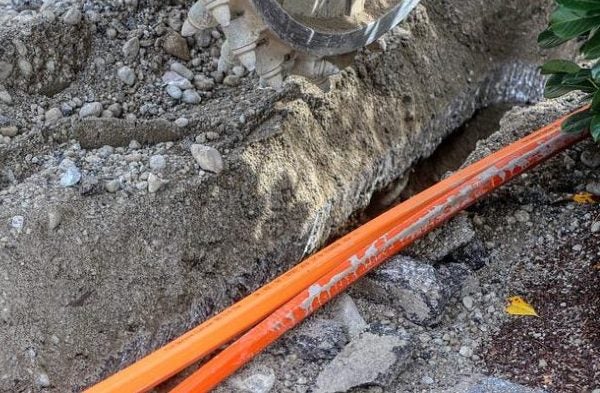Fiber installation leads to road damage in Lunenburg County
Published 7:47 am Wednesday, November 1, 2023
|
Getting your Trinity Audio player ready...
|
Road damage that occurred as part of Kinex Telecom’s fiber optic cable installation in Lunenburg County will be repaired in the next few weeks.
Some damage to the shoulders of Brickland and Hickory roads occurred as contractors work to wrap up the fiber optic cabling there, Kinex President Jim Garrett said in a Wednesday, Oct. 25 interview.
“The damage on Hickory appeared to be the edge of a tar and gravel portion of the road that was very thin from wear already, so the shoulder just wasn’t capable of handling a moving 20,000-pound machine,” Garrett said. “The shoulder on Brickland appeared to have a very thick asphalt base, but it appeared that the soil under it was no longer compacted and it gave way in a spot.”
He explained these issues are inevitable just because of the size and weight of the machine and the condition of the roads or the base under the roads.
With the high cost of installing fiber optic cables, Garret explained why Kinex is using the plow option in the area.
“We could bore more of it and have less machine traffic, but the cost of plowing a mile of fiber or innerduct is about $20,000 a mile and boring it in is about $64,000 a mile,” he said.
This is just labor cost and does not include materials, Garret noted, adding that there is an additional cost of about $8,000 a mile to blow the fiber into the duct.
VDOT officials aware
Virginia Department of Transportation Richmond District Communications Manager Lorena Arias said officials are aware of the damage to the edge of the pavement near Kenbridge resulting from plowing in fiber cable.
“The damage has not caused any impact to motorists in those areas,” Arias said. “Kinex is responsible for all repairs and a plan is in place for repairs to be made by a contractor.”
Garrett said VDOT has approved contractors and that they’ve contacted an approved paving contractor to fix the road.
“The contractor has been backlogged because like everyone else … in this tight labor market, but it will be fixed in the next several weeks,” he explained. “VDOT is working with us and knows the situation.”
Arias said Kinex is working in Lunenburg County under a Land Use Permit for installing fiber for broadband along the VDOT Right-of-Way. “The safety of all motorists and pedestrians is our top priority and we will continue to oversee the repair project through its completion,” she added.
Garrett said this type of damage can be expected on secondary roads when contractors bring in the 20,000-pound machine for such projects.
“Sometimes you can’t know how the base or foundation is on the edge of that road,” he said. “We brief the operators to be careful, but some damage is inevitable.”
As the work continues, it is important for those driving in these areas to heighten their awareness.
“Sometimes there are lane closures, but we have really pushed our safety personnel to be alert and to stay safe,” Garrett said. “We ask that everyone think about making sure we all go home to our families each night.”
With the lane closures, Kinex constantly audits its safety crews.
“We ask that everyone pay attention to their directives in order to keep everyone safe,” he said.
Update on Lunenburg County fiber installation
Garrett hopes Kinex’s fiber optic installation project will be complete by 2025, but may not wrap up until 2026.
“The federal government has $42.5 billion it expects to release for rural fiber projects next year and I expect we will see material shortages, the labor market will tighten even further,” Garrett said, “and all of those factors will raise the cost of doing business, so that makes it difficult to predict an accurate time frame.”
He said this is a four-year, four-phase project that will hopefully be completed sooner.
Garrett said they’ve converted a substantial number of clients to fiber in Lunenburg from the company’s earlier project and they are adding clients to that fiber almost weekly.
Kinex is adding multiple numbers of clients on the Prince Edward fiber each day and Garrett expects they will be adding more along Route 15 and into Lunenburg by the end of the year or first part of next year.
“Because we were in Prince Edward earlier, we had a chance to finish and close out some permits to free up bond money,” he said. “So after just finishing most of Phase I Lunenburg County, we are moving back into Prince Edward for a few months, while we wait for repairs in Lunenburg so we can close up some permits and open up new ones, then move back into Lunenburg.”
Garrett noted this is a 100% underground project that takes more time and money than aerial installation.
“We have to get the innerduct in the ground for most of the fiber, emplace the hand holes, blow the fiber through innerduct, splice it together at all of the joining ends, splice in splitters, test each fiber service area before accepting it from the contractor, cross road bore to clients on the other side of the street, plow the fiber into the yards, place the network interface box on the house, test the fiber to the house, run fiber into the house, then install electronics,” he explained. “We recently brought in some additional contractors for splicing and yard deployment, to break the backlog of people waiting while we were building the infrastructure. So please be patient, we are making good progress.”
Why fiber optic?
Fiber Internet is the gold standard for internet service, Garrett said.
Many people get 5 megabyte (MB) or 10 MB service with their DSL service and may find it not consistent or reliable.
“DSL is served on copper that was meant to connect analog phone service and now Telcos are pushing that medium beyond its limits,” he said. “The electronic devices we are installing will allow us to serve a connection at 1,000 times the speed of that 10 MB DSL — 10 gigabyte (GB) — and it doesn’t fade in and out.”
Years from now, Garret said they will deploy the newest electronics that they are perfecting in labs today.
“On that same fiber we will be able to produce speeds 4,000 times as fast as that 10 MB DSL, 40 GB,” he said.






